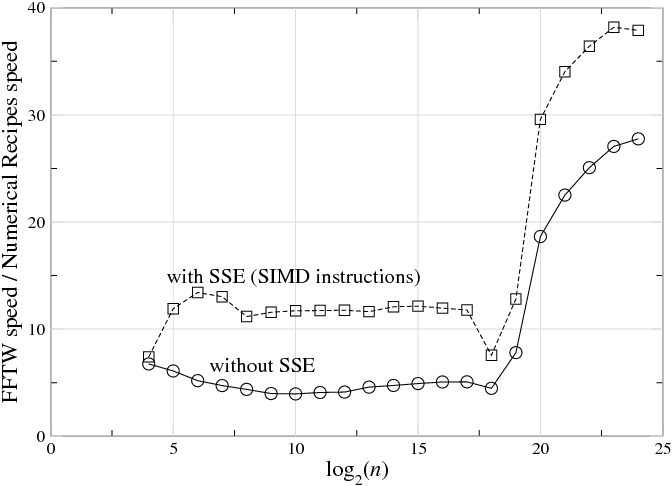| << Chapter < Page | Chapter >> Page > |
by Steven G. Johnson (Department of Mathematics, Massachusetts Institute of Technology) and Matteo Frigo (Cilk Arts, Inc.)
Although there are a wide range of fast Fourier transform (FFT)
algorithms, involving a wealth of mathematics from number theory topolynomial algebras, the vast majority of FFT implementations in
practice employ some variation on the Cooley-Tukeyalgorithm
[link] . The Cooley-Tukey algorithm can be
derived in two or three lines of elementary algebra. It can beimplemented almost as easily, especially if only power-of-two sizes
are desired; numerous popular textbooks list short FFT subroutinesfor power-of-two sizes, written in the language
For many years, the primary route to improving upon the Cooley-Tukey FFT seemed to be reductions in the count of arithmetic operations,which often dominated the execution time prior to the ubiquity of fast floating-point hardware (at least on non-embedded processors). Therefore, great effort was expended towardsfinding new algorithms with reduced arithmetic counts [link] , from Winograd's method to achieve multiplications We employ the standard asymptotic notation of for asymptotic upper bounds, for asymptotic tight bounds, and for asymptotic lower bounds [link] . (at the cost of many more additions) [link] , [link] , [link] , [link] to the split-radix variant on Cooley-Tukey that long achieved the lowestknown total count of additions and multiplications for power-of-two sizes [link] , [link] , [link] , [link] , [link] (but was recently improved upon [link] , [link] ). The question of the minimum possible arithmetic count continues to be of fundamentaltheoretical interest—it is not even known whether better than complexity is possible, since lower bounds on the count of additions have only been proven subject to restrictive assumptions about thealgorithms [link] , [link] , [link] . Nevertheless, the difference in the number of arithmetic operations, forpower-of-two sizes , between the 1965 radix-2 Cooley-Tukey algorithm ( [link] ) and the currently lowest-known arithmetic count ( [link] , [link] ) remains only about 25%.


Notification Switch
Would you like to follow the 'Fast fourier transforms' conversation and receive update notifications?